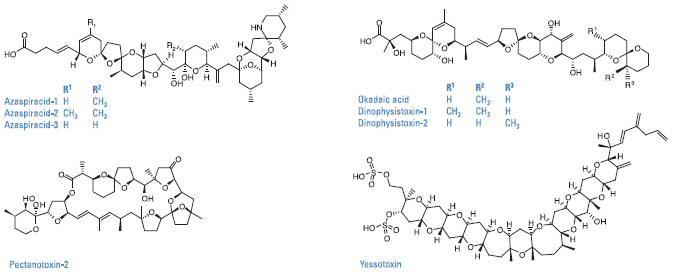
NCCOS scientists developed a new, effective method to ensure safe shellfish harvesting in Washington state, increasingly threatened by known and emerging algal bloom (HAB) toxins. The new technique improves upon an existing, commonly used testing methodology for lipophilic (dissolvable in fats, oils, lipids) HAB toxins.
This fast and accurate method improves analytical performance, simplifies testing procedures, and allows tests to run on less sophisticated, lower cost equipment often used in budget-restricted state regulatory laboratories. The protocol determines levels of several lipophilic toxin classes in a single sample, enhances toxin extraction efficiencies, and reduces sample matrix issues as compared to current methods. Moreover, the newly developed test is likely transferable for use with shellfish species in other US regions affected by HABs producing these lipophilic toxins.
The new quantitative methodology relies on the analytical chemistry technique called liquid chromatography-tandem mass spectrometry (LC-MS/MS) to concurrently measure levels of multiple lipophilic HAB toxin classes in a shellfish sample. The toxins detected with the new technique include azaspiracids (AZAs), yessotoxins (YTXs) and pectenotoxins (PTXs), along with the diarrhetic shellfish poisoning (DSP) toxins free okadaic acid (OA) and free dinophysistoxins (DTXs), in an untreated extract, as well as total OA and total DTXs (including their esters) in a hydrolyzed extract.
The method was validated for determination of US FDA-regulated toxins (AZAs and DSP) in five popularly consumed regional shellfish species from the Pacific Northwest region (California mussel, blue mussel, littleneck clam, Manila clam, Pacific oyster) and toxins not currently regulated by the US FDA (YTXs and PTX) as they occur in some of these species.
The work, published in the Journal of Chromatography A, was supported through a NCCOS MERHAB project involving partners from NOAA Fisheries, WA Dept. of Health, US FDA, Jamestown S’Klallam Tribe, and the Alfred Wegener Institute. The new methodology will contribute to WA State’s ability to protect public health, enhance food security, and secure shellfish revenue.

Citation: Wang, Zhihong and Gregory J. Doucette. 2021. Determination of lipophilic marine biotoxins by liquid chromatography-tandem mass spectrometry in five shellfish species from Washington State, USA. Journal of Chromatography A 1639, 461902. https://doi.org/10.1016/j.chroma.2021.461902
